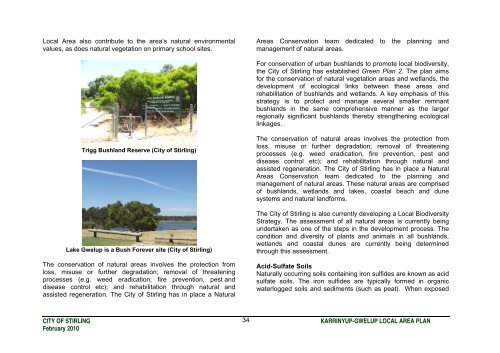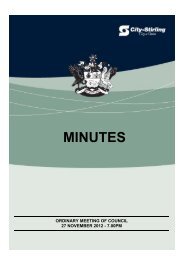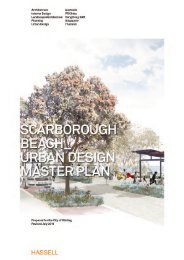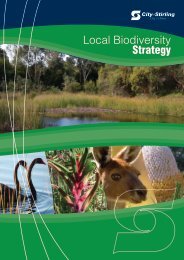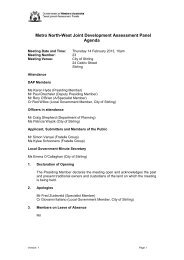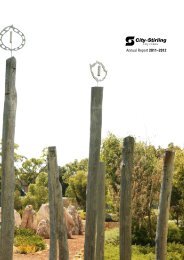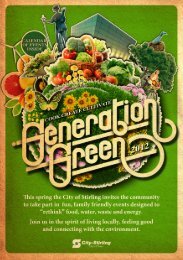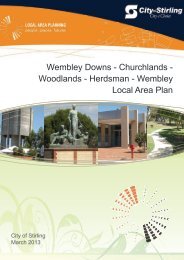KARRINYUP / GWELUP Local Area Plan - City of Stirling
KARRINYUP / GWELUP Local Area Plan - City of Stirling
KARRINYUP / GWELUP Local Area Plan - City of Stirling
You also want an ePaper? Increase the reach of your titles
YUMPU automatically turns print PDFs into web optimized ePapers that Google loves.
<strong>Local</strong> <strong>Area</strong> also contribute to the area’s natural environmental<br />
values, as does natural vegetation on primary school sites.<br />
<strong>Area</strong>s Conservation team dedicated to the planning and<br />
management <strong>of</strong> natural areas.<br />
For conservation <strong>of</strong> urban bushlands to promote local biodiversity,<br />
the <strong>City</strong> <strong>of</strong> <strong>Stirling</strong> has established Green <strong>Plan</strong> 2. The plan aims<br />
for the conservation <strong>of</strong> natural vegetation areas and wetlands, the<br />
development <strong>of</strong> ecological links between these areas and<br />
rehabilitation <strong>of</strong> bushlands and wetlands. A key emphasis <strong>of</strong> this<br />
strategy is to protect and manage several smaller remnant<br />
bushlands in the same comprehensive manner as the larger<br />
regionally significant bushlands thereby strengthening ecological<br />
linkages.<br />
Trigg Bushland Reserve (<strong>City</strong> <strong>of</strong> <strong>Stirling</strong>)<br />
Lake Gwelup is a Bush Forever site (<strong>City</strong> <strong>of</strong> <strong>Stirling</strong>)<br />
The co nservation <strong>of</strong> natural areas involves the protection from<br />
loss, misuse or further degradation; removal <strong>of</strong> threatening<br />
processes (e.g. weed eradication, fire prevention, pest and<br />
disease control etc); and rehabilitation through natural and<br />
assisted regeneration. The <strong>City</strong> <strong>of</strong> <strong>Stirling</strong> has in place a Natural<br />
The conservation <strong>of</strong> natural areas involves the protection from<br />
loss, misuse or further degradation; removal <strong>of</strong> threatening<br />
processes (e.g. weed eradication, fire prevention, pest and<br />
disease control etc); and rehabilitation through natural and<br />
assisted regeneration. The <strong>City</strong> <strong>of</strong> <strong>Stirling</strong> has in place a Natural<br />
<strong>Area</strong>s Conservation team dedicated to the planning and<br />
management <strong>of</strong> natural areas. These natural areas are comprised<br />
<strong>of</strong> bushlands, wetlands and lakes, coastal beach and dune<br />
systems and natural landforms.<br />
The <strong>City</strong> <strong>of</strong> <strong>Stirling</strong> is also currently developing a <strong>Local</strong> Biodiversity<br />
Strategy. The assessment <strong>of</strong> all natural areas is currently being<br />
undertaken as one <strong>of</strong> the steps in the development process. The<br />
condition and diversity <strong>of</strong> plants and animals in all bushlands,<br />
wetlands and coastal dunes are currently being determined<br />
through this assessment.<br />
Acid-Sulfate Soils<br />
Naturally occurring soils containing iron sulfides are known as acid<br />
sulfate soils. The iron sulfides are typically formed in organic<br />
waterlogged soils and sediments (such as peat). When exposed<br />
CITY OF STIRLING 34<br />
<strong>KARRINYUP</strong>-<strong>GWELUP</strong> LOCAL AREA PLAN<br />
February 2010


